229 Search Results for partner strategies
May 18, 2017
by Carole Zangari -
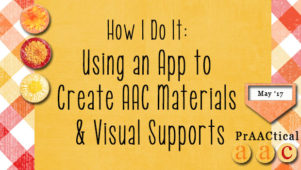
When we think of AAC apps, expressive communication and voice output generally come to mind. But there are other kinds of AAC apps, too, including those that are used to create printable materials. Today, we hear from a clinician who uses this kind of AAC app on a regular basis. Georgia Karavias is a speech language pathologist whose career has centered around working with school-aged children and adolescents who have physical disabilities and communication difficulties. Georgia is passionate about utilizing alternative access methods and inclusive technologies to enable independent communication using AAC systems. She currently works at Scope’s Communication and Inclusion Resource Centre (CIRC) as part of the communication access team in a community capacity building role. In this post, she talks about how she uses AAC and visual supports created with an app developed at her workplace. :::::::::::::::::::::::::::::::::::::::::::::::::::::::::::::::::::::::::::::::::::::::::::::::::::::::: I am a speech pathologist who has worked with children with complex... [Read More...]
May 11, 2017
by Carole Zangari -
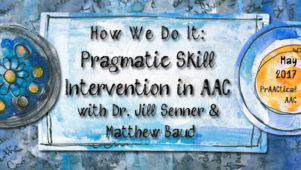
Better Hearing and Speech Month is in full swing and we are excited to see SLPs talking about tools and strategies for supporting people with AAC needs. Many individuals with AAC needs have difficulty using language in expected ways, particularly in social interactions. In this post, we welcome back guest authors Jill Senner and Matthew Baud to discuss ways in which they target pragmatic language in their clinical work. They have a prAACtical approach to this subject and are generous in sharing AAC resources, including vocabulary/pagesets for some popular AAC apps/SGDs. Enjoy! ::::::::::::::::::::::::::::::::::::::::::::::::::::::::::::::::::::: Chat with Me: Pragmatic Skill Intervention in AAC with Jill E Senner, PhD, CCC-SLP & Matthew R. Baud, MS, CCC-SLP Pragmatic skills, commonly referred to as social skills, play an important role in the successful integration of individuals with disabilities. People with disabilities need adequate social skills to live and be educated in the least restrictive environment, to be... [Read More...]
January 26, 2017
by Carole Zangari -
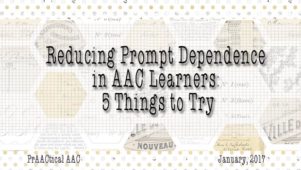
“He knows what to do. He just doesn’t do it.” “He’s prompt-dependent. How can I get him to use AAC on his own?” “I love his strong-willed nature, but it works against him sometimes. He doesn’t initiate.” If any of these remarks sound familiar, it may be time to think about alternative approaches to build independent communication. Here are a few things to try with AAC users who’ve learned to wait for support before communicating. Exaggerate the pause time: Many of our AAC learners need at least 5 seconds of pause time after a communication opportunity presents itself. This helps them process the experience, organize their thoughts, decide on a response, and then begin to execute that response. Sometimes, though, we work with people who’ve learned that if they just wait, the communication partner will start to help (whether or not they need it). We can sometimes nudge the learner... [Read More...]
December 29, 2016
by Carole Zangari -
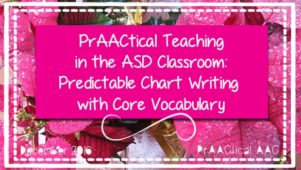
We are closing out the year with a bang by combining two of our favorite things: working on AAC and literacy. In this post, Michigan-based teachers Amy Devin and Lauren Pawlowski return to discuss their strategies for building communication skills in the context of writing activities. Enjoy their detailed descriptions of how they implement a 5-day writing sequence in their classrooms! :::::::::::::::::::::::::::::::::::::::::::::::::::::::::::::::: Predictable Chart Writing with Core Vocabulary If writing with your students is something you are apprehensive about, then Predictable Chart writing is a good place to start. You get a lot of bang for your buck, as you can work on many different concepts as you are instructing through the week. Some areas you will be able to work on is location and meaning of core, concepts about print, print awareness and fine motor skills. Prior to starting your Predictable Chart Writing, you have to have a plan on which... [Read More...]
November 27, 2016
by Carole Zangari -
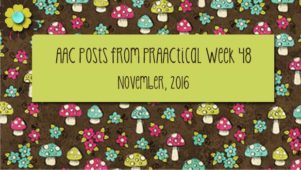
Monday – AAC Learning at ASHA 2016: Day 1 Wednesday – Video of the Week: Improving Literacy Outcomes for Individuals with ASD and Limited Speech Thursday – A Day for Giving Thanks Friday – PrAACtical Resources: AAC Partner Training Strategies
November 21, 2016
by Carole Zangari -
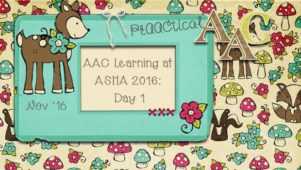
As usual, the ASHA Annual Convention was so chock full of AAC learning opportunities that there was no way to get to everything of interest. Here are some handouts on AAC topics from the first day of the conference. Aided Language Stimulation for All Communication Partners of Children Who Use AAC by Eric Sailers of Expressive Solutions and Jhoselle Padilla at Chula Vista Elementary School District AAC Multidisciplinary Treatment for Communication & Functional Participation by Amy Sonntag of Ohio State University and Lindsay Ripple of Akron Children’s Hospital “A Picture’s Worth a Thousand Words.” An AAC Intervention for Children With Complex Communication Needs by Jamie Boster and John McCarthy of Ohio State University Expanding & Customizing Spanish Core Vocabulary for Augmentative & Alternative Communication by Amy Munekata, Bridget Carlile, and Lisa Domby of the University of North Carolina – Chapel Hill An Analysis of Conversational Interaction of an Individual With... [Read More...]
June 20, 2016
by Carole Zangari -
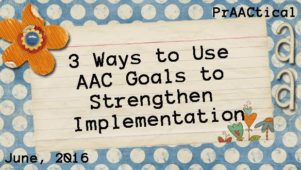
Concerned about AAC systems not being implemented as often as they should? Looking for ways to help AAC learners gain additional practice? Trying to help colleagues build the habit of actively supporting AAC learners? You are not alone. There are several strategies to boost the use of AAC, and adding some key phrases to the goals we write is one of them. Here are some thoughts on ways to use goals to strengthen the day-to-day AAC experiences of the learners with whom we work. Aided Language Input: Experienced AAC professionals and knowledgeable families understand that consistent use of this strategy is the most powerful way to build AAC use. If this is an issue for your AAC teams, consider adding verbiage to the goals that mandate the use of this strategy. Examples: “Given consistent AAC modeling, ___ will…” “When provided with aided language input, ___ will…” Frequent Implementation: Like many... [Read More...]
June 1, 2016
by Carole Zangari -
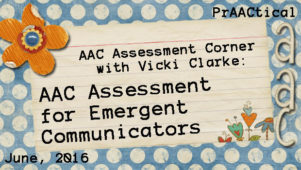
Today, we welcome back Vicki Clarke with more helpful information on conducting AAC assessments. If you work with individual who are at the early stages of communicative development, this post is for you! :::::::::::::::::::::::::::::::::::::::::::::::::::::::::: Some of my most favorite students are those who, at first, may not seem to notice me at all. Sometimes these students seem to exist in their own worlds. They don’t seem to respond in ways we would expect: looking, attending, listening, or gesturing. They may have a diagnosis of Autism, significant developmental delay, epilepsy, or any number of syndromes. I love these kids, and unfortunately, these are often the students who don’t get referred to me. Sometimes it takes years of working in a district before I get to see students with significant developmental delays. These children are typically served in classrooms for students considered to be severe/profound or multi-handicapped. Honestly, I usually get the... [Read More...]
May 5, 2016
by Carole Zangari -
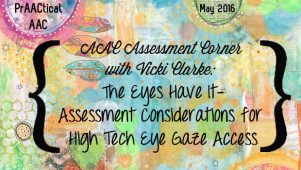
AAC assessment is an area that most professionals struggle with for one reason or another. I am so grateful to Vicki Clarke for returning to share her thoughts on the prAACticalities of conducting these evaluations. If you are looking for tips on assessing someone who needs high tech eye gaze AAC, this post is for you. For other posts authored by Vicki, click here. ::::::::::::::::::::::::::::::::::::::::::::::::::::::::::: The Eyes Have It: Assessment Considerations for High Tech Eye Gaze Access Eye gaze control for AAC device access is a hallmark technological achievement in the world of speech generating devices. For people with significant motor challenges we are no longer limited to scanning as our one choice for AAC access. AAC Specialists have been using light tech eye gaze boards and PVC pipe frames with these friends for years, but now we are able to offer voice output. Eye gaze is for a much... [Read More...]
February 23, 2016
by Carole Zangari -

AAC learners need a lot of support as they build the skills needed to have rich and effective conversations. Often, their role in the conversation is punctuated with partners’ reliance on context, prior knowledge, and questions to make sense of the message. What do we do when the learner gives us partial information or uses language skills below his/her capability? Do we accept the limited language so that we get to the bottom of the message our learner is trying to express? Or do we use it as an opportunity to shape improved language skills? One approach to making this decision is to start with a question. “What is the top priority for this interaction?” Making a decision about the most important goal of the conversation is a critical step in determining how to respond. In some cases, the time is right to use the opportunity to improve skills in... [Read More...]









